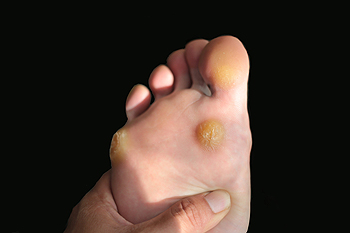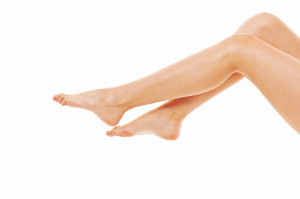Exercises for Heel Spurs
 When there is excessive stress in the heel, new bone is formed to protect the heel against fractures. This is known as a heel spur and often feels like a bump in the heel. It typically begins as cartilage and then progresses into solid bone. They’re present in about half the population, although not everyone has pain. The most common cause of heel spurs is plantar fasciitis. If pain is experienced, it’s usually in the morning or after resting. Typically, after the first few steps, the pain will improve as the foot gets used to the movements. Certain exercises may also help relieve the pain. Placing the affected foot on a tennis ball while rolling it around may be beneficial in relaxing the muscles. Additionally, bending the knees while moving up and down may provide additional relief.
When there is excessive stress in the heel, new bone is formed to protect the heel against fractures. This is known as a heel spur and often feels like a bump in the heel. It typically begins as cartilage and then progresses into solid bone. They’re present in about half the population, although not everyone has pain. The most common cause of heel spurs is plantar fasciitis. If pain is experienced, it’s usually in the morning or after resting. Typically, after the first few steps, the pain will improve as the foot gets used to the movements. Certain exercises may also help relieve the pain. Placing the affected foot on a tennis ball while rolling it around may be beneficial in relaxing the muscles. Additionally, bending the knees while moving up and down may provide additional relief.
Heel spurs can be incredibly painful and sometimes may make you unable to participate in physical activities. To get medical care for your heel spurs, contact Dr. Steven Shlonsky from Louisville, Kentucky. Dr. Shlonsky will do everything possible to treat your condition.
Heels Spurs
Heel spurs are formed by calcium deposits on the back of the foot where the heel is. This can also be caused by small fragments of bone breaking off one section of the foot, attaching onto the back of the foot. Heel spurs can also be bone growth on the back of the foot and may grow in the direction of the arch of the foot.
Older individuals usually suffer from heel spurs and pain sometimes intensifies with age. One of the main condition's spurs are related to is plantar fasciitis.
Pain
The pain associated with spurs is often because of weight placed on the feet. When someone is walking, their entire weight is concentrated on the feet. Bone spurs then have the tendency to affect other bones and tissues around the foot. As the pain continues, the feet will become tender and sensitive over time.
Treatments
There are many ways to treat heel spurs. If one is suffering from heel spurs in conjunction with pain, there are several methods for healing. Medication, surgery, and herbal care are some options.
If you have any questions feel free to contact our office located in Louisville, KY . We offer the latest in diagnostic and treatment technology to meet your needs.
Caring for a Diabetic Foot Ulcer
 If feet are deprived of blood that's rich in oxygen, a condition called diabetic foot can occur. It is typically characterized by open wounds or sores, usually located on the sole of the foot. The high blood sugar may damage blood vessels, causing poor circulation in the feet and legs. Foot ulcers may then be a result of this and can be very slow to heal. Checking the feet for cuts and sores, in addition to learning how to keep the feet clean and dry, is crucial for patients. For people with severe foot ulcers, special shoes may be needed. It’s important for the ulcer to be treated properly by washing it well with saline or clean tap water and then covering it with a bandage to control drainage. You should seek immediate treatment from a podiatrist if you think you have a diabetic foot ulcer.
If feet are deprived of blood that's rich in oxygen, a condition called diabetic foot can occur. It is typically characterized by open wounds or sores, usually located on the sole of the foot. The high blood sugar may damage blood vessels, causing poor circulation in the feet and legs. Foot ulcers may then be a result of this and can be very slow to heal. Checking the feet for cuts and sores, in addition to learning how to keep the feet clean and dry, is crucial for patients. For people with severe foot ulcers, special shoes may be needed. It’s important for the ulcer to be treated properly by washing it well with saline or clean tap water and then covering it with a bandage to control drainage. You should seek immediate treatment from a podiatrist if you think you have a diabetic foot ulcer.
Diabetic foot care is important in preventing foot ailments such as ulcers. If you are suffering from diabetes or have any other concerns about your feet, contact Dr. Steven Shlonsky from Louisville, Kentucky. Dr. Shlonsky can provide the care you need to keep you pain-free and on your feet.
Diabetic Foot Care
Diabetes affects millions of people every year. The condition can damage blood vessels in many parts of the body, especially the feet. Because of this, taking care of your feet is essential if you have diabetes, and having a podiatrist help monitor your foot health is highly recommended.
The Importance of Caring for Your Feet
- Routinely inspect your feet for bruises or sores.
- Wear socks that fit your feet comfortably.
- Wear comfortable shoes that provide adequate support.
Patients with diabetes should have their doctor monitor their blood levels, as blood sugar levels play such a huge role in diabetic care. Monitoring these levels on a regular basis is highly advised.
It is always best to inform your healthcare professional of any concerns you may have regarding your feet, especially for diabetic patients. Early treatment and routine foot examinations are keys to maintaining proper health, especially because severe complications can arise if proper treatment is not applied.
If you have any questions please feel free to contact our office located in Louisville, KY . We offer the newest diagnostic and treatment technologies for all your foot and ankle needs.
Causes of Ingrown Toenails
When there is an imbalance in the size of the nail and the enlargement of the skin edge, this may cause an ingrown toenail. Reasons for this may include the nail naturally growing inward, improper shoe fitting, and hereditary conditions. Other causes may be from an improper pedicure and/or poor foot hygiene. Common symptoms can be tenderness of the nail, swelling and redness. Additionally, drainage and pus may occur if there is an infection involved. Home remedies may include soaking the affected toe in lukewarm water, or applying antibacterial ointments for bacterial infections and antifungal ointments for fungal infections. Those who have diabetes or poor circulation are advised to consult a podiatrist even if the symptoms appear to be mild.
Ingrown toenails can become painful if they are not treated properly. For more information about ingrown toenails, contact Dr. Steven Shlonsky of Louisville, Kentucky. Dr. Shlonsky can provide the care you need to keep you pain-free and on your feet.
Ingrown Toenails
Ingrown toenails occur when a toenail grows sideways into the bed of the nail, causing pain, swelling, and possibly infection.
Causes
- Bacterial infections
- Improper nail cutting such as cutting it too short or not straight across
- Trauma to the toe, such as stubbing, which causes the nail to grow back irregularly
- Ill-fitting shoes that bunch the toes too close together
- Genetic predisposition
Prevention
Because ingrown toenails are not something found outside of shoe-wearing cultures, going barefoot as often as possible will decrease the likeliness of developing ingrown toenails. Wearing proper fitting shoes and using proper cutting techniques will also help decrease your risk of developing ingrown toenails.
Treatment
Ingrown toenails are a very treatable foot condition. In minor cases, soaking the affected area in salt or antibacterial soaps will not only help with the ingrown nail itself, but also help prevent any infections from occurring. In more severe cases, surgery is an option. In either case, speaking to your podiatrist about this condition will help you get a better understanding of specific treatment options that are right for you.
If you have any questions please feel free to contact our office located in Louisville, KY . We offer the newest diagnostic and treatment technologies for all your foot and ankle needs.
Different Types of Corns
 If you have a hard, thickened area of skin on the foot you may possibly have a corn. This condition comes from rubbing, which puts pressure on the skin. Corns form on the feet, which may make walking difficult and painful. There are a few different types of corns, one being soft which typically develops between the toes. Another type is a hard corn, which is a small patch of thickened skin with a portion of softer skin in the center. There are also seed corns that consist of a group of smaller corns, and tend to occur on the bottom of the feet. Ill-fitting shoes are the most common causes of this foot disorder. Women are more likely to develop corns because of frequent wearing of high heels. These shoes put pressure on the toes which can lead to thickening of skin on the foot. Wearing shoes without socks may be another cause of corns, which can lead to friction
If you have a hard, thickened area of skin on the foot you may possibly have a corn. This condition comes from rubbing, which puts pressure on the skin. Corns form on the feet, which may make walking difficult and painful. There are a few different types of corns, one being soft which typically develops between the toes. Another type is a hard corn, which is a small patch of thickened skin with a portion of softer skin in the center. There are also seed corns that consist of a group of smaller corns, and tend to occur on the bottom of the feet. Ill-fitting shoes are the most common causes of this foot disorder. Women are more likely to develop corns because of frequent wearing of high heels. These shoes put pressure on the toes which can lead to thickening of skin on the foot. Wearing shoes without socks may be another cause of corns, which can lead to friction
If you have any concerns regarding your feet and ankles, contact Dr. Steven Shlonsky of Louisville, Kentucky. Dr. Shlonsky will treat your foot and ankle needs.
Corns: What Are They? and How Do You Get Rid of Them?
Corns can be described as areas of the skin that have thickened to the point of becoming painful or irritating. They are often layers and layers of the skin that have become dry and rough, and are normally smaller than calluses.
Ways to Prevent Corns
There are many ways to get rid of painful corns such as wearing:
- Well-fitting socks
- Comfortable shoes that are not tight around your foot
- Shoes that offer support
Treating Corns
Treatment of corns involves removing the dead skin that has built up in the specific area of the foot. Consult with Dr. Shlonsky to determine the best treatment option for your case of corns.
If you have any questions please feel free to contact our office located in Louisville, KY . We offer the newest diagnostic and treatment technologies for all your foot and ankle needs.








